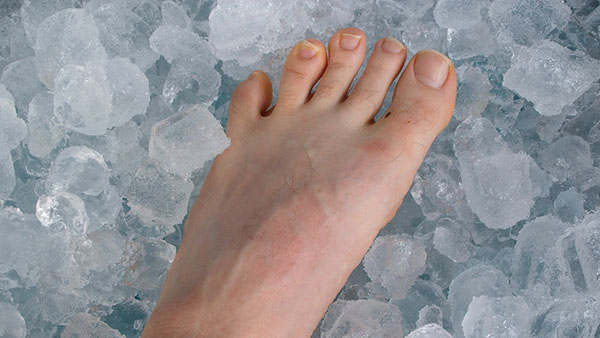Cold treatment can be really useful after any foot and ankle injuries. Ice can help reduce pain and swelling which can in turn speed up healing. But did you know that if it is used incorrectly it can actually make things worse? Here we will look at how to use ice safely and effectively to get the maximum benefit.
When you use ice, you cool down the soft tissues i.e. skin, muscles, ligaments, tendons etc. This causes the blood vessels to constrict, known as vasoconstriction which reduces the blood flow to the area and therefore the bleeding into an area. By reducing this blood flow, you reduce the amount of swelling.
Why Do You Want to Reduce Swelling?

The main reason is that reducing swelling usually reduces pain and improves how much movement you have. Swelling occurs when there is extra fluid which takes up space which increases the pressure in the joint or muscle and in turn limits the amount of movement eg how much you can move your foot up and down. This fluid also contains inflammatory chemicals which irritate the surrounding nerves and tissues causing pain.
When Should You Use Ice?
Cold Treatment is most effective the first few days following an injury or surgery but can be used longer term with persistent swelling.
How Should You Apply It?

You should never place ice directly on your skin as it can cause and ice burn. Instead, either wrap ice in a tea towel or place it in a specially designed ice bag or you can use ice packs specially designed for treating injuries.
Wait 2 hours before reapplying cold therapy to allow the tissues to warm up again. You can read this article on Ice Wraps to find out more about different ways to apply ice and find the one that will best suit you.
How Long Should You Apply Ice For?
The optimum time to use ice therapy for is approximately 10-15 minutes. Any longer than this and you can cause an ice burn or the effect of the ice can actually be reversed – instead of blood vessels constricting they actually start to open up (vasodilatation) which increases the blood flow to the area, rather than reducing it. This is known as the Hunting Effect.
Are There Any Times You Should Not Use Ice?
Yes, in some situations it is not advisable to use cold therapy. Do not use ice if you have:
1) Decreased Sensation: as you may cause yourself an ice burn.
2) High Blood Pressure: the vasoconstrictive effect of ice can raise blood pressure.
3) Heart Problems: If you have heart problems or decreased circulation such as peripheral vascular disease you should not use ice therapy
4) Open Wound: Do not place ice directly over an open wound
5) Raynaud’s Disease: a rare disease affecting blood vessels
6) Age: The elderly and young children should not be treated with ice therapy
If you are experiencing issues with your feet, contact Achilles Podiatry for further evaluation and treatment.
Source: Foot Pain

